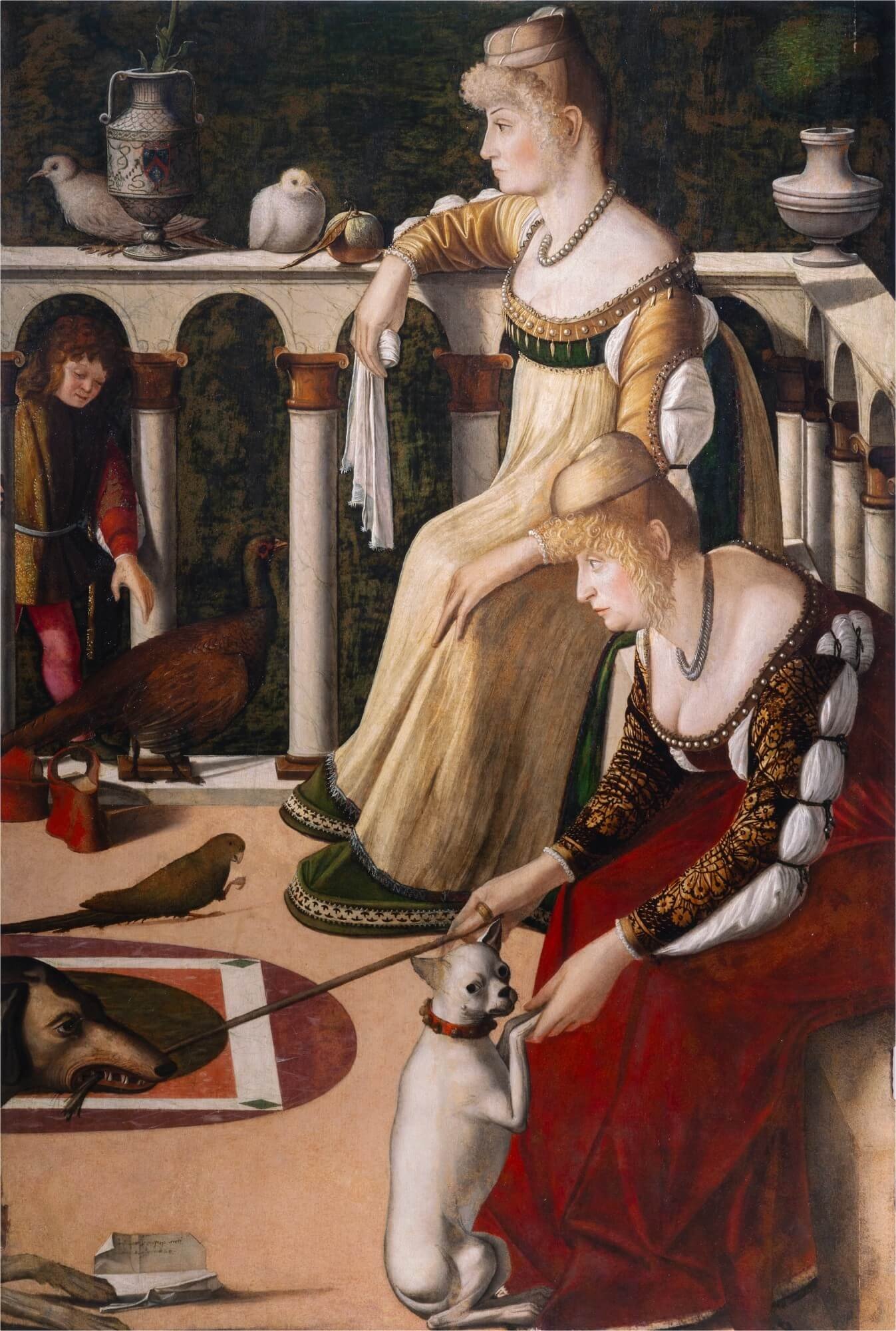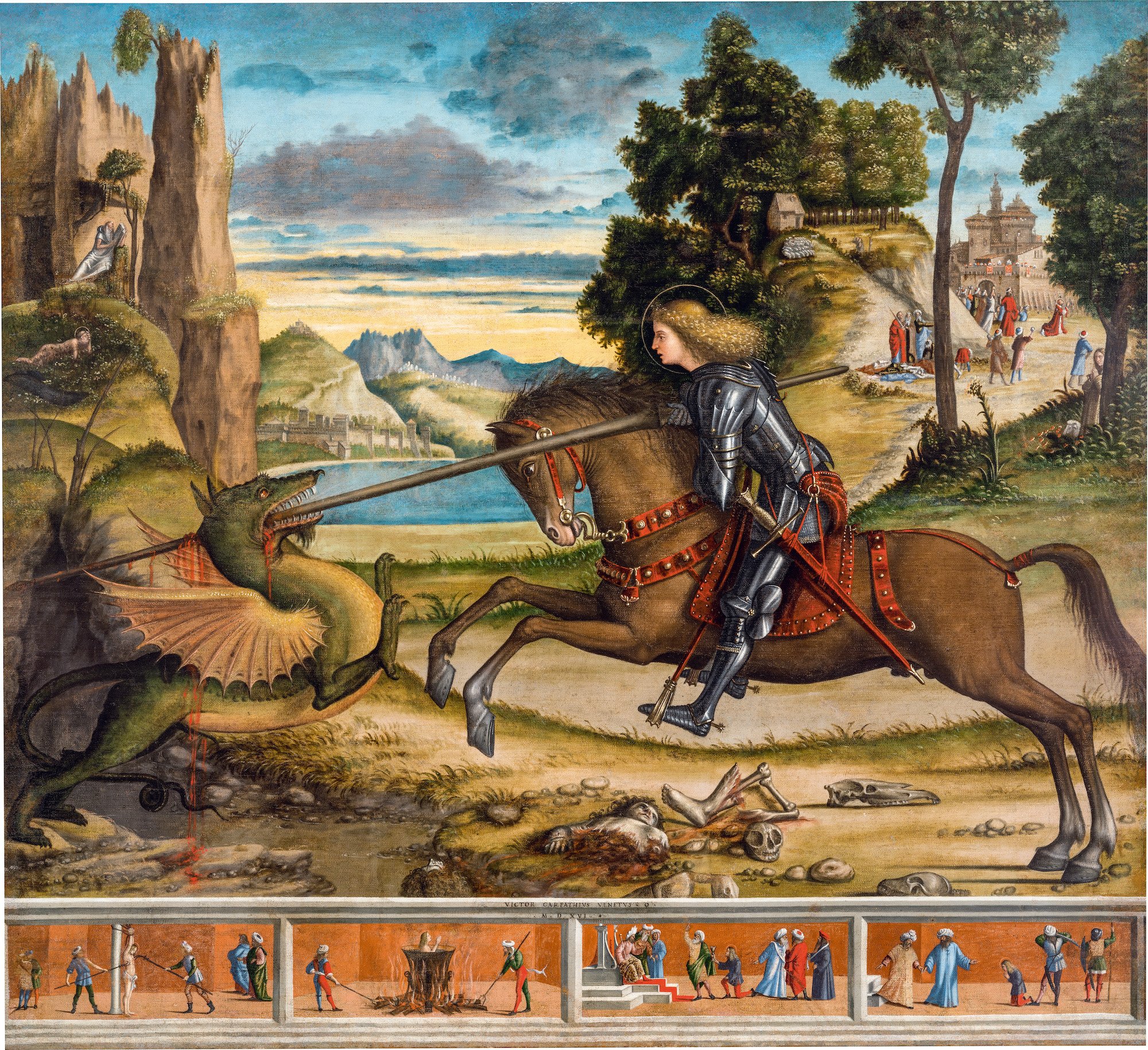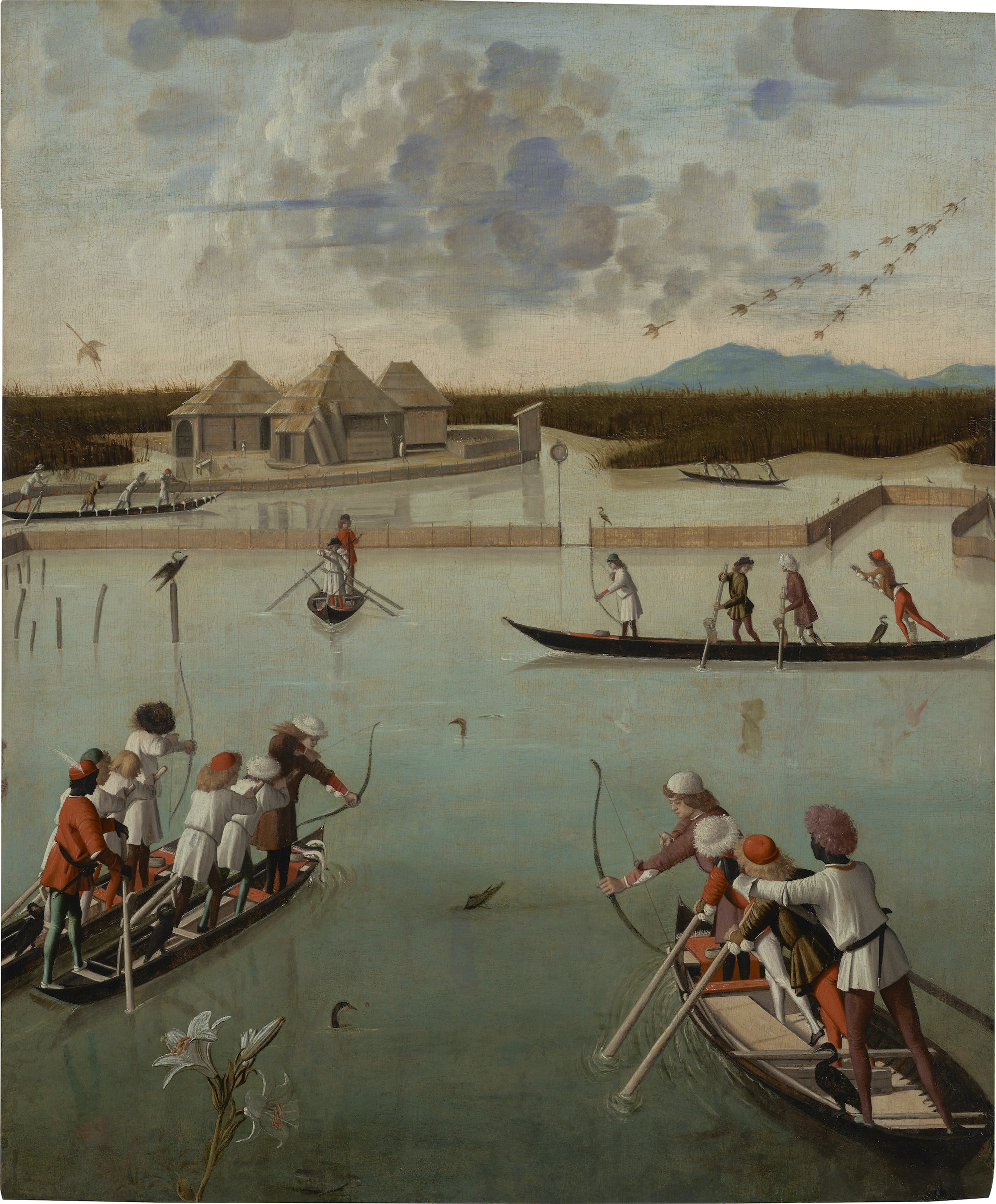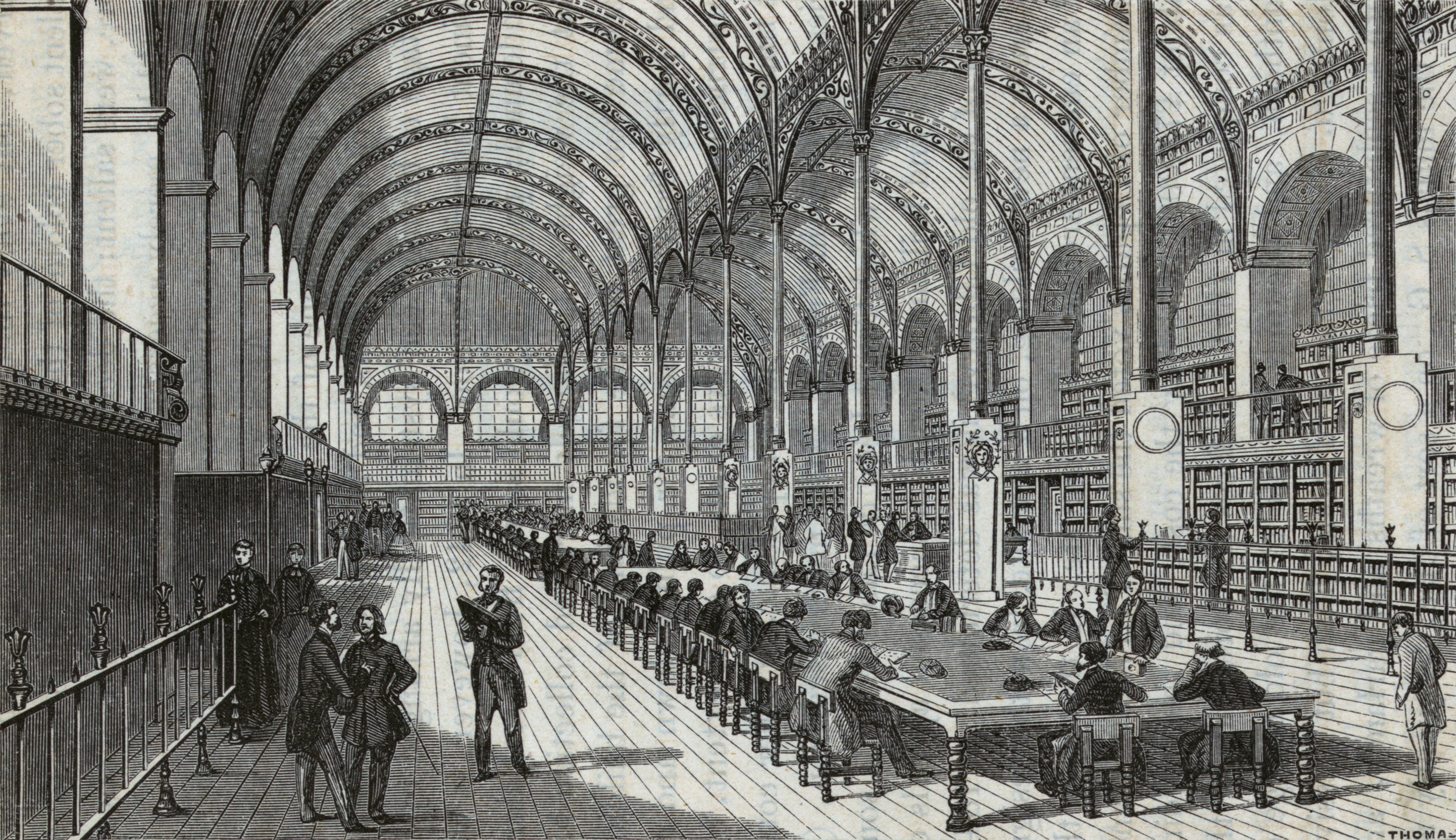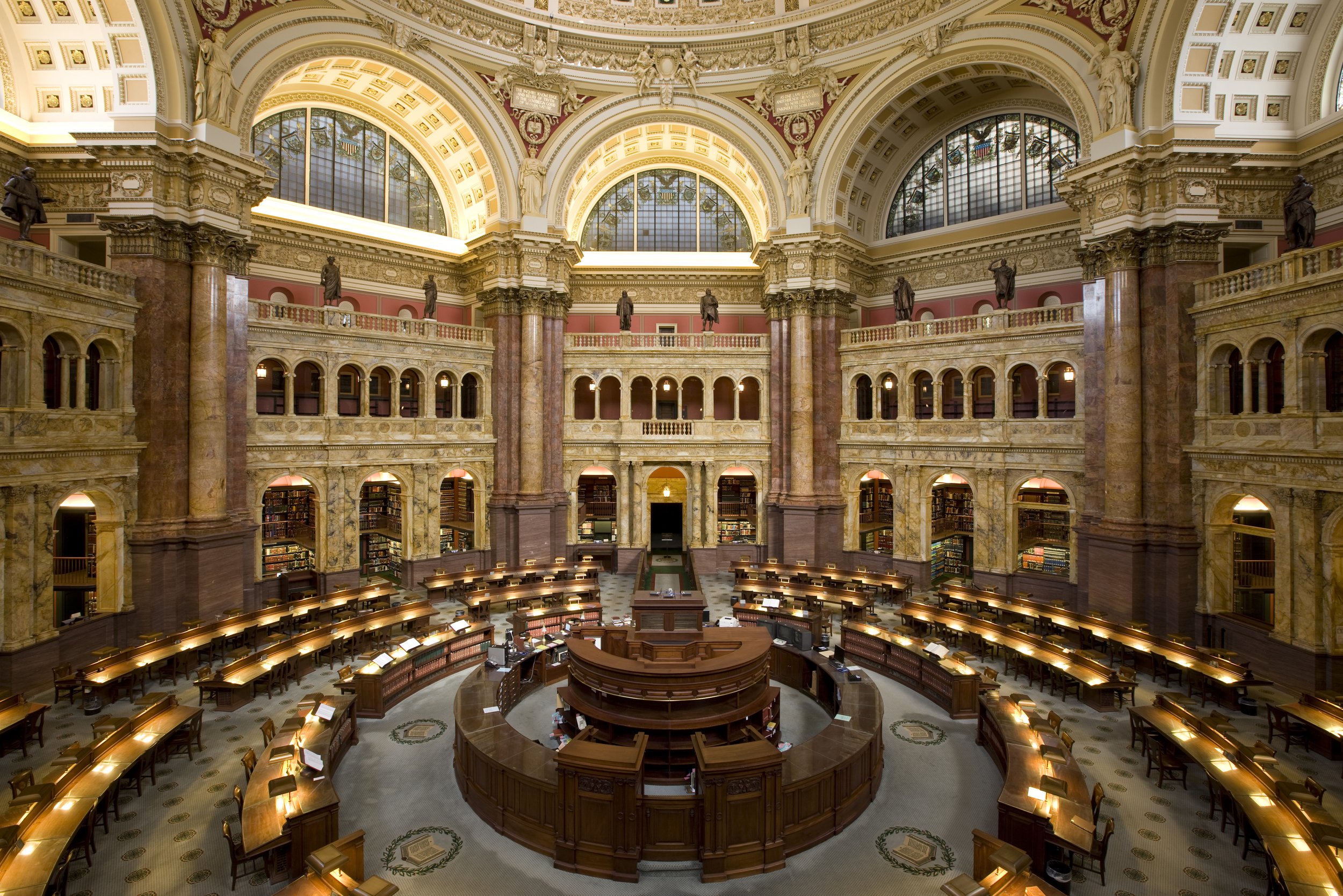THE NEW CRITERION, February 2023
On “Vittore Carpaccio: Master Storyteller of Renaissance Venice” at the National Gallery of Art, Washington, D.C.
It is the contemporary fate of Vittore Carpaccio (ca. 1465–1525), the Venetian painter of the late fifteenth and early sixteenth centuries, now with a major new exhibition at the National Gallery of Art, to share his name with a popular dish of sliced raw beef.1 The joint appellation, as it turns out, is not a coincidence. In 1963 the Palazzo Ducale organized its first ever retrospective of this “master Storyteller of Renaissance Venice,” as the National Gallery dubs its current show. La Serenissima at the time was awash in Carpacciomania, so much so that Giuseppe Cipriani, the owner of Harry’s Bar, named his culinary invention after the reds of the appetizing painter.
The famous restaurateur was not alone in appreciating the taste of this last of the Venetian “Primitives”—one who was sandwiched, as it were, between the coolness of Giovanni Bellini and the maniera moderna warmth of Titian and Giorgione. A little over a century before Cipriani paid his respects, John Ruskin unearthed Carpaccio among his stones of Venice. The painter sent Ruskin into a “reverie” approaching a “delirium of fantasy.” Then as now the artist’s great appeal was his stunning architectural staging, one that sets his mythological, biblical, and historical storytelling in idealized Venetian cityscapes.
Vittore Carpaccio, Two Women on a Balcony, ca. 1492/1494, Oil on panel, Fondazione Musei Civici di Venezia, Museo Correr, Venice.
In his Guide to the Principal Pictures in the Academy of Fine Arts at Venice of 1877, Ruskin placed Carpaccio at the apex of Venice’s “classic and mythic” age. An honorary member of the Accademia, for weeks Ruskin sat and copied Carpaccio’s monumental cycle of paintings of Saint Ursula, the artist’s most famous set of works, originally created for the Scuola di Sant’Orsola confraternity. “I went crazy about Saint Ursula,” he said of the recently restored works in the Accademia museum. In St. Mark’s Rest, his epilogue to The Stones of Venice, Ruskin even bumped Bellini from his top spot to declare Carpaccio’s Two Women on a Balcony, in the Museo Correr across the Grand Canal, as “The best picture in the world . . . and I know no other picture in the world which can be compared to it.”
In 1882 Henry James set out on his own Venetian tour, Ruskin’s “generous lamp” in hand. In works such as Saint George and the Dragon and Saint Augustine in His Study, James found a “paradise of his own room.” Unlike the “vertical” pull of much of Italian art, James appreciated the “horizontal” window that Carpaccio opened onto the spiritual world, with the terrestrial and the celestial seeming to cohabitate in our own temporal space. Placing him among his favorites Bellini and Tintoretto, James declared that Carpaccio was the “most personal and sociable of artists” for his “care for human life at large.” The anchoring of Carpaccio’s safe harbors seemingly in the actual stones of Venice—with marble paving stones and building façades receding in perspective view—has appealed in many times of rebuilding and renewal: for example during the French Second Empire, through such artists as Gustave Moreau, and following World War I, in the neoclassical fantasies of Giorgio de Chirico.
The times must be right again for another Carpaccio rediscovery. Fortunately the National Gallery (and, undoubtedly, only the National Gallery) has the lending power to mount a major stateside survey of the artist. The first outside of Italy, the display should enkindle our own Carpacciomania. Curated by Peter Humfrey in collaboration with Andrea Bellieni and Gretchen Hirschauer, the exhibition is presented in partnership with the Fondazione Musei Civici di Venezia—which, as with their joint 2018–19 exhibition of Jacopo Tintoretto, will also mount the show at the Palazzo Ducale. In Washington, even without some of his most significant paintings on offer, in particular those from his expansive Saint Ursula cycle, “Vittore Carpaccio: Master Storyteller of Renaissance Venice” features forty-five paintings and thirty drawings. Gathering work from some forty-eight venues, the transporting exhibition leaves us with much to chew on.
Vittore Carpaccio, Saint George and the Dragon, 1516, Oil on canvas, Abbazia di San Giorgio Maggiore, Benedicti Claustra Onlus, Venice. Photo courtesy of Abbazia di San Giorgio Maggiore, Benedicti Claustra Onlus.
While little is known of the young Carpaccio, he clearly became intoxicated by three Bellinis: the brothers Giovanni and Gentile and their father, Jacopo. Together they developed and refined the Venetian understanding of single-point perspective. As an apprentice to the Bellini sons (whether he trained with Giovanni or Gentile or both is not entirely certain), Carpaccio inflated their compositional inventiveness to maximum volumetric effect. Never before had paintings breathed with quite so much fresh air.
Like the brothers Bellini, Carpaccio worked with oil on canvas rather than in fresco, as the new medium was far more resilient in the humid Venetian climate. The availability of printed books and woodcuts added elements of the northern Renaissance to Carpaccio’s cosmopolitan mix, with printed maps and depictions of distant lands informing his visual concatenations.
The results are indeed storytelling at its most masterly. And rather than overwhelming us with such monumental painting cycles as his Saint Ursula, which at nine feet tall by eight to twenty feet wide (and again newly restored) remains in situ at the Gallerie dell’Accademia, “Vittore Carpaccio: Master Storyteller of Renaissance Venice” helps us appreciate the painter on a more intimate scale with smaller works. Assembled here, the altarpieces, private devotional paintings, smaller confraternity commissions, and studies and cartoons that he made in preparation for his larger compositions all speak to the artist’s consummate craft and the particular interests of his Venetian patronage.
Carpaccio was the opposite of groundbreaking. In his compositional structuring, he was fortifying. His imaginative worlds were perfected 3D environments, premium-engineered with all Venetian-made parts. Into his spaces he arranged numerous figures far more occupied with one another than with our own subjective point of view. Unlike the later artists of the Venetian cinquecento, with Carpaccio there is no heavy artistic hand to draw us in. We instead get a self-contained universe, a sim-Serenissima where the activities exhibit the same ordered rules as the compositions’ single-point perspectives.
Vittore Carpaccio, Fishing and Fowling on the Lagoon (recto); Letter Rack (verso), ca. 1492/1494, Oil on panel, The J. Paul Getty Museum, Los Angeles. Digital image courtesy of the Getty’s Open Content Program.
The exhibition begins with Ruskin’s “best picture in the world,” the Two Women on a Balcony—but here presented even better than in Ruskin’s day. Sometime in the 1700s this small work, most likely part of a set of folding shutter doors painted for a Venetian palace, was divided from its upper half. The lower portion with the two women eventually went to Venice’s Museo Correr. The upper part, now titled Fishing and Fowling on the Lagoon, ended up at the J. Paul Getty Museum in Los Angeles. The panels, dated together to ca. 1492/94, were only reidentified as being part of the same composition after conservation efforts in the early 1990s. This exhibition now temporarily reunites for only the second time in recent history what was clearly intended to be a single whole—the line of a lily stem even connects the two parts. Their happy reunion begs to remain permanent, if only the Getty and Correr could arrive at a loan agreement to share the works.
In the lower panel, the women gather on a balcony filled with birds and dogs. The scene is busy with domestic activity even if the women (and their dogs) appear somewhat bored by the pet play. The upper panel suggests the reason for their tedium. Above and beyond them, the men have loaded onto their gondola-like boats for a lively hunting and fishing expedition out on the lagoon. The components together reveal the ordering of Venetian society in one view. As both groups contend with their animals, the women in the foreground, who seem little interested in what is happening below the balcony, add humor to the recreation of their husbands beyond. The clever division and animated activity of the entire panel reveal Carpaccio’s great ingenuity with composition, compressing and expanding space to his will to contain his full “care for human life at large,” as Henry James put it. That the scene is clearly cut off to the left would certainly suggest that some additional Carpaccio is still out there waiting to be rediscovered—just look for the matching balustrade and rear end of a brown dog. Adding to this intrigue, the verso of part of the known panel is painted with personal letters appearing to hang from a line in trompe l’oeil. As much as we might appreciate him by the slice, Carpaccio is best enjoyed whole.
The organization of Carpaccio’s compositions was no accident. His studies of faces, architecture, and perspective were exacting. His deliberative process might help explain why we are now left with more of Carpaccio’s preparatory work than almost any other artist of his time. The National Gallery presents thirty of these drawings both to let us appreciate his working methods and to help illustrate his larger paintings that cannot travel. Among these examples, a blue double-sided sheet from the Ashmolean Museum in Oxford is a standout. Titled Head of a Young Woman in Profile (recto) and Head of a Young Woman in Three-Quarter View (verso), the drawings from ca. 1488–89 served as studies for two of the numerous faces in Carpaccio’s Apotheosis of Saint Ursula, one of the paintings in the Accademia cycle. The drawings are not necessarily innovative. They even may have been copies of works by Pietro Perugino and Pinturicchio. Still, through their exquisite modeling created with hatch marks of white and black chalk and washes of brush and brown, they reveal a luminous grace.
Carpaccio’s extensive compositional planning did not necessarily serve him well as his reputation contended with the rise of the modern style of Titian and Giorgione. Even at the time of Ruskin, in 1871, Joseph Archer Crowe and Giovanni Battista Cavalcaselle wrote that Carpaccio was “without any poetry of fancy” in their History of Painting in North Italy. In her current catalogue essay, “Carpaccio as a Draftsman,” Catherine Whistler concurs that he was “overshadowed by the poetic genius of Titian.” Even Peter Humphrey writes that “set against the more heroic and classicizing art, the work of Carpaccio must have appeared staid, quaint, and irrelevant.” At the very least, Humphrey continues, “his narrative paintings and skills as a storyteller may be seen as a vital link in the continuous tradition in Venetian painting from the late Gothic style of the early fifteenth century to the late baroque of the eighteenth.”
But there is more to Carpaccio than merely his role as a historical connection between the painting styles of fifteenth- and sixteenth-century Venice. His appeal is in locating us in spiritual space and infusing this built environment with pious order. We can see why the scuole, those social and charitable organizations of Venice, all commissioned him to paint their lives of Saint George and Saint Stephen and Saint Ursula and the Virgin Mary. The worlds he envisioned were immersive. They could be entered, touched, and breathed. The paradise he creates is indeed “of his own room,” to which he extends a welcoming invitation.
“Vittore Carpaccio: Master Storyteller of Renaissance Venice” opened at the National Gallery of Art, Washington, D.C., on November 20, 2022, and remains on view through February 12, 2023. The exhibition will next be on view at the Fondazione Musei Civici, Palazzo Ducale, Venice (March 18–June 18, 2023).

